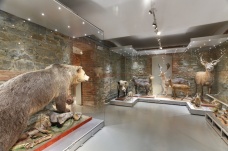The Silesian landscape conceals a large amount of information on its own history. The geological part of the exhibition gives a brief overview of the origins and geological development using exhibits from Silesia and north Moravia. From a geological point of view, this is a highly varied field, because it is in Silesia that two different geological zones – the Bohemian massif and the Carpathian range – come into contact. Deposits of coal formed in the top, carboniferous layer to form the Upper Silesian Coal Basin – the Ostrava-Karviná Coal Basin.
Silesia is the most significant area of quaternary glaciation in the Czech Republic. Of special interest are the Silesian volcanoes from the end of the Neogene and beginning of the Quaternary Periods, such as Velký Roudný, Uhlířský vrch, Mezina and Bílčice. Fossils show the development of plants and animals on the territory of Silesia, from the Palaeozoic to the Quaternary Era. Apart from the carboniferous layers, Mesozoic sediments, which are particularly rich in flora and fauna, are best preserved in the Moravian-Silesian Beskids range, part of the Carpathian range created in the Cenozoic Era.
The unique Štramberk limestone, created through the accumulation of the skeletons of marine organisms, is of special significance and is particularly rich in animal fossils. The coral reef by Štramberk is amongst the richest paleontological sites in the Czech Republic. The final Tertiary flood reached as far as the Opava and Hlučín regions and created deposits of gypsum containing remarkable exemplars of flora and fauna (for example at Kobeřice, where the only currently mined gypsum deposit in the Czech Republic is located).
The botanical part of the exhibition contains exemplars of mosses, lichens and fungi, combined with herbaria of major representatives of plant families, with a focus on botanically interesting protected areas (Velká Kotlina, Praděd, Mionší, Radhošť National Parks etc.), endemic species and relicts from Silesia and north Moravia. The zoological part of the exhibition focuses primarily on species that are found in Silesia. The display starts with the simplest life forms, moving up through single-celled organisms, via molluscs and arthropods up to vertebrates.
Article last updated: 09.05.2018
Print whole article





